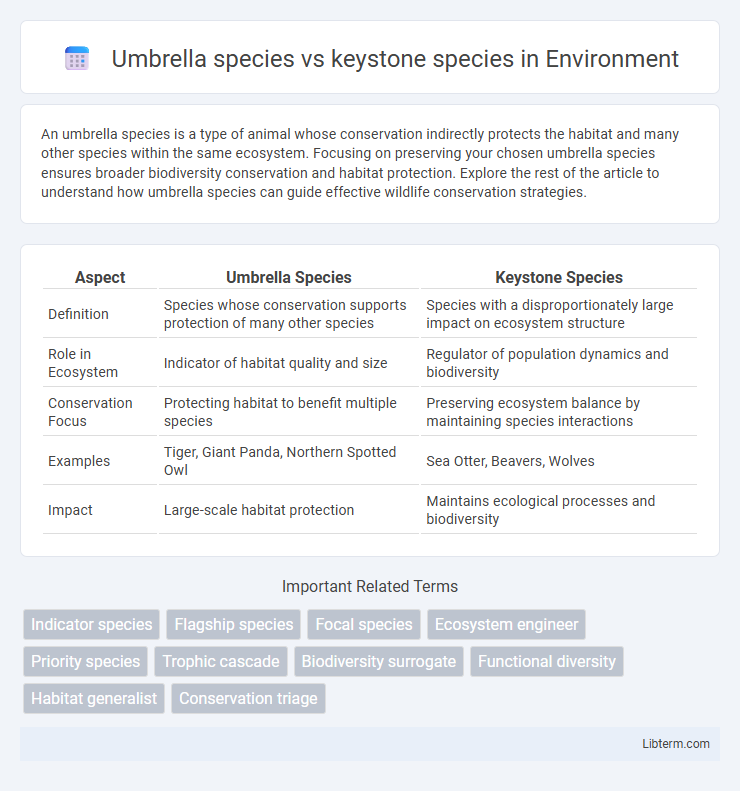An umbrella species is a type of animal whose conservation indirectly protects the habitat and many other species within the same ecosystem. Focusing on preserving your chosen umbrella species ensures broader biodiversity conservation and habitat protection. Explore the rest of the article to understand how umbrella species can guide effective wildlife conservation strategies.
Table of Comparison
| Aspect | Umbrella Species | Keystone Species |
|---|---|---|
| Definition | Species whose conservation supports protection of many other species | Species with a disproportionately large impact on ecosystem structure |
| Role in Ecosystem | Indicator of habitat quality and size | Regulator of population dynamics and biodiversity |
| Conservation Focus | Protecting habitat to benefit multiple species | Preserving ecosystem balance by maintaining species interactions |
| Examples | Tiger, Giant Panda, Northern Spotted Owl | Sea Otter, Beavers, Wolves |
| Impact | Large-scale habitat protection | Maintains ecological processes and biodiversity |
Understanding Umbrella Species
Umbrella species are organisms whose conservation indirectly protects numerous other species within the same habitat due to their extensive habitat requirements. Protecting umbrella species like tigers or grizzly bears preserves large ecosystems, benefiting biodiversity on a broad scale. This approach helps prioritize conservation efforts efficiently by focusing on species with wide-ranging ecological impacts.
Defining Keystone Species
Keystone species are organisms that play a critical role in maintaining the structure and stability of an ecosystem, often influencing the diversity and population sizes of other species. Unlike umbrella species, whose conservation indirectly protects many other species by virtue of their large habitat requirements, keystone species exert a disproportionate ecological impact relative to their abundance. Examples of keystone species include sea otters, which control sea urchin populations and preserve kelp forest ecosystems, and wolves, which regulate prey populations and promote biodiversity.
Core Differences Between Umbrella and Keystone Species
Umbrella species are organisms whose conservation indirectly protects a wide range of other species by preserving large habitats, while keystone species have a disproportionately large effect on ecosystem structure and function relative to their abundance. The core difference lies in their ecological roles: umbrella species serve as proxies for habitat conservation efforts, whereas keystone species regulate ecosystem dynamics and maintain biodiversity. Protecting keystone species often results in cascading impacts on multiple trophic levels, whereas conserving umbrella species primarily benefits associated species sharing the same habitat.
Ecological Roles & Functions
Umbrella species require large habitat areas for survival, and their conservation indirectly protects numerous other species within the same ecosystems, enhancing overall biodiversity. Keystone species have a disproportionate impact on ecosystem structure and function through their specific ecological roles, such as predation, pollination, or habitat modification. Protecting keystone species maintains essential ecosystem processes and stability, while safeguarding umbrella species ensures broader habitat preservation and species community protection.
Conservation Strategies Involving Umbrella Species
Conservation strategies involving umbrella species prioritize protecting habitats that benefit multiple co-occurring species, leveraging the broad-ranging needs of these species to maximize ecosystem preservation. Umbrella species, such as tigers or spotted owls, require large territories, so safeguarding their habitats indirectly conserves numerous lesser-known species sharing the same ecosystem. This approach streamlines conservation efforts by targeting species whose protection translates to wider biodiversity benefits, optimizing resource allocation and habitat connectivity.
Keystone Species: Impacts on Ecosystem Structure
Keystone species play a critical role in maintaining ecosystem structure by regulating population dynamics and promoting biodiversity, often causing disproportionate effects relative to their abundance. Their presence influences trophic interactions, habitat complexity, and nutrient cycling, thereby stabilizing ecosystems and enhancing resilience. Removal of keystone species can trigger cascading extinctions and habitat degradation, underscoring their integral function in ecosystem stability and health.
Case Studies: Umbrella Species in Action
The northern spotted owl serves as a prime example of an umbrella species, where conservation efforts aimed at protecting its habitat also safeguard numerous other species within the old-growth forests of the Pacific Northwest. Similarly, the tiger in India acts as an umbrella species, with its conservation ensuring the preservation of vast forest ecosystems that support diverse wildlife, including prey species and countless plants. These case studies demonstrate how focusing protection on umbrella species effectively conserves broader ecological communities.
Notable Examples of Keystone Species
Notable examples of keystone species include sea otters, which control sea urchin populations and maintain kelp forest health, and wolves in Yellowstone National Park, whose predation regulates herbivore numbers and fosters biodiversity. Fig trees act as keystone species in tropical forests by providing critical fruit resources year-round for numerous animals. These species have disproportionate ecological impacts compared to umbrella species, which primarily serve as conservation flagships to protect broader habitats.
Challenges and Limitations in Species Selection
Selecting umbrella species often faces challenges due to their extensive habitat requirements, which may not encompass the needs of all co-occurring species, limiting conservation effectiveness. Keystone species selection is complicated by the difficulty in accurately identifying their ecosystem roles and interactions, as their impact can vary spatially and temporally. Both approaches face limitations related to incomplete ecological data and potential biases, hindering optimal species prioritization for biodiversity management.
Integrating Approaches for Effective Biodiversity Protection
Integrating umbrella species and keystone species concepts enhances biodiversity protection by targeting both broad habitat conservation and critical ecological functions. Protecting umbrella species safeguards extensive ecosystems and numerous co-occurring species, while keystone species conservation ensures ecosystem stability through roles like predation or seed dispersal. Combining these approaches enables comprehensive strategies that address habitat preservation and maintain ecosystem processes vital for biodiversity resilience.
Umbrella species Infographic

 libterm.com
libterm.com